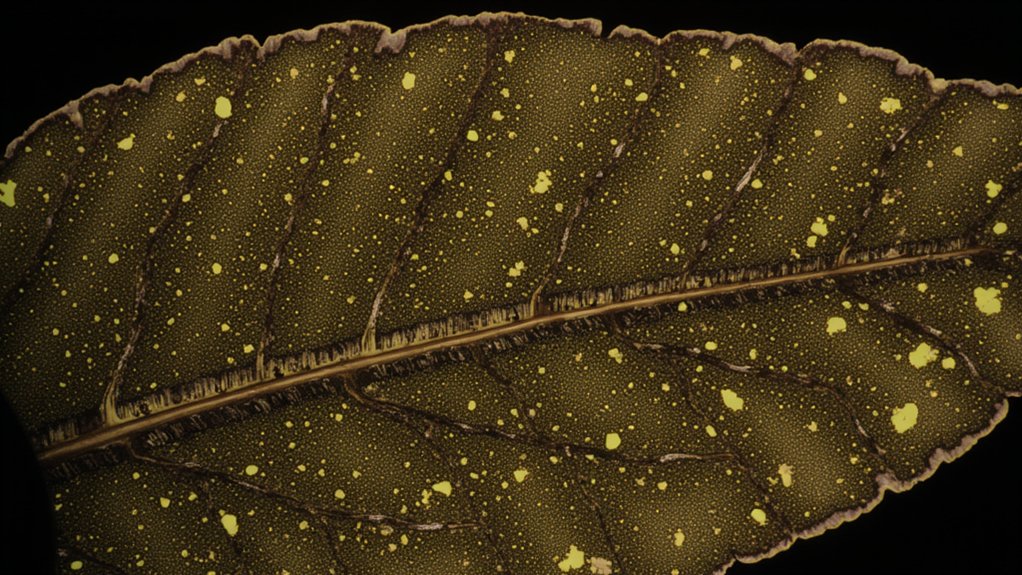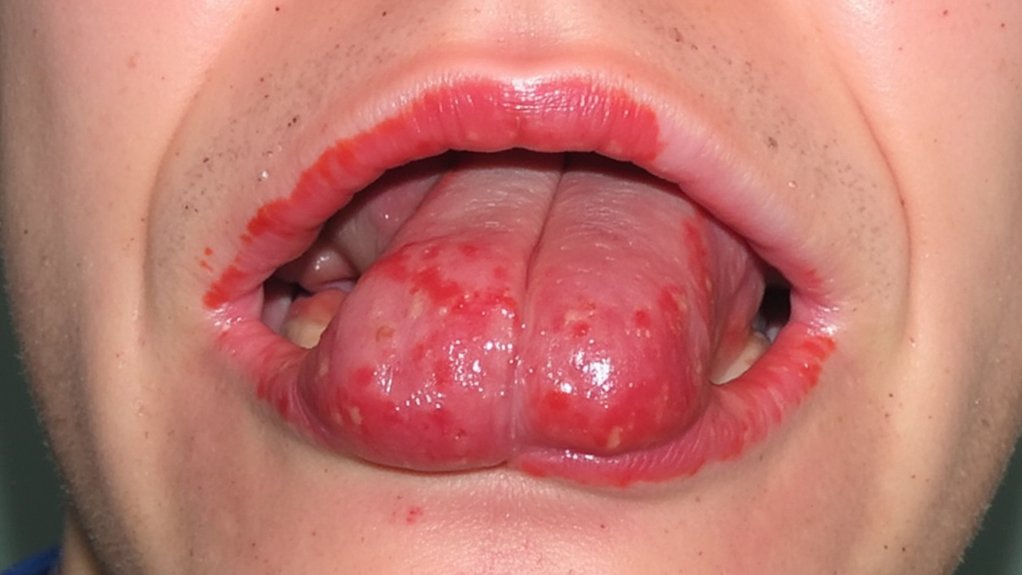Like a silent sentinel in your living room, the Dieffenbachia’s lush leaves hide a microscopic arsenal of needle-sharp crystals that can temporarily rob you of speech. You’ve probably walked past this common houseplant dozens of times without realizing its powerful defensive mechanism. Behind its innocent, tropical appearance lies a fascinating story of botanical chemistry, historical misuse, and modern-day caution that might change how you view this deceptively beautiful plant.
Contents
- 1 The Science Behind Calcium Oxalate Crystals
- 2 Historical Background and Cultural Significance
- 3 Identifying Symptoms of Dieffenbachia Exposure
- 4 Essential Safety Measures for Handling
- 5 Growing and Caring for Your Dieffenbachia
- 6 Common Varieties and Their Characteristics
- 7 Medical Treatment for Dieffenbachia Poisoning
- 8 Safe Alternatives for Homes With Children and Pets
The Science Behind Calcium Oxalate Crystals

While most houseplants are relatively harmless, Dieffenbachia contains microscopic calcium oxalate crystals that make it one of the most toxic indoor plants. These needle-shaped crystals, called raphides, measure just 0.2 micrometers in width and cluster by the thousands inside the plant’s cells.
When you bite or chew Dieffenbachia’s leaves or stems, these crystals instantly penetrate your mouth’s soft tissues. They’ll pierce your tongue, throat, and mucous membranes like tiny arrows, causing immediate swelling and intense burning. Your body’s inflammatory response to these crystal injuries can make your tongue swell so much that you temporarily lose the ability to speak.
Historical Background and Cultural Significance

These dangerous calcium oxalate crystals didn’t stop people throughout history from finding unique uses for Dieffenbachia. In South American indigenous cultures, you’ll find records dating back to the 1600s of tribal healers using diluted plant extracts for treating arthritis and joint inflammation.
During the colonial era, plantation owners discovered a darker application: they’d use the plant’s sap to punish slaves by temporarily paralyzing their vocal cords, leading to its common name “dumb cane.” You can still find references to this practice in historical documents from Caribbean sugar plantations between 1750-1850.
Today, you’ll find Dieffenbachia primarily as an ornamental plant, though some traditional medicine practitioners still use it cautiously.
Identifying Symptoms of Dieffenbachia Exposure

Contact with Dieffenbachia triggers a rapid onset of distinct symptoms that you’ll need to identify quickly for proper treatment. When the plant’s sap touches your skin, you’ll notice immediate burning and irritation, often followed by redness and swelling within minutes.
If you’ve gotten the sap in your mouth, you’ll experience intense burning, followed by swelling of your tongue and throat. Your speech may become temporarily impaired, hence the plant’s nickname “dumb cane.” Difficulty swallowing and excessive drooling are also common reactions.
Eye contact causes severe pain, redness, and watery discharge. These symptoms typically last 24-48 hours without treatment.
Essential Safety Measures for Handling
Understanding the severity of Dieffenbachia’s effects makes proper handling techniques a top priority. You’ll need thick, waterproof gloves that extend past your wrists, and it is crucial to keep your face at least 12 inches away from the plant while working with it.
When pruning or repotting, wear protective eyewear and long sleeves. Don’t touch your face or any exposed skin until you’ve thoroughly washed your hands with soap and warm water for at least 20 seconds, even if you’re wearing gloves.
Store your gardening tools separately and label them “for Dieffenbachia use only” to prevent cross-contamination with other plants.
Growing and Caring for Your Dieffenbachia
While Dieffenbachia plants have earned their toxic reputation, they’re surprisingly easy to grow with proper care and attention. Place your plant in bright, indirect sunlight and maintain temperatures between 65-80°F. Water thoroughly when the top inch of soil feels dry, but don’t let the roots sit in standing water.
Your Dieffenbachia will thrive in well-draining potting mix with monthly fertilizer applications during the growing season. Prune yellow leaves at the base, and wipe dust from the foliage with a damp cloth every few weeks. If leaves droop, you’re likely overwatering – adjust accordingly and guarantee good drainage.
Common Varieties and Their Characteristics
Dieffenbachia comes in several striking varieties, each with its own unique leaf patterns and growth habits. The ‘Camille’ variety features cream-colored centers with dark green edges, growing up to 6 feet tall, while ‘Tropic Snow’ displays speckled leaves with white margins.
You’ll find ‘Amoena’ sporting deep green leaves with lighter veining, reaching heights of 3-4 feet. The compact ‘Compacta’ variety, perfect for smaller spaces, grows only 2-3 feet tall with densely packed foliage.
‘Sterling’ showcases silver-gray leaves with dark green borders, and the popular ‘Mary’ variety exhibits yellow-green centers surrounded by forest green edges.
Medical Treatment for Dieffenbachia Poisoning
If you’ve been exposed to dieffenbachia’s toxic sap, seeking immediate medical attention is essential, especially when severe symptoms develop. Your doctor will first rinse your mouth with cold water and may administer an antihistamine to reduce swelling.
For skin contact, you’ll need to wash the affected area thoroughly with soap and water for 15-20 minutes. In cases of eye exposure, flush your eyes with clean water for at least 20 minutes before seeing an ophthalmologist.
If you’ve ingested plant material, don’t induce vomiting. Your healthcare provider might give you activated charcoal and monitor your airways until symptoms subside, typically within 24 hours.
Safe Alternatives for Homes With Children and Pets
Looking for pet and child-safe alternatives to dieffenbachia doesn’t mean you’ll have to sacrifice style or beauty in your home. Consider the elegant Boston fern, which thrives in indirect light and adds cascading greenery without any toxic components.
The African violet, growing 6-8 inches tall, offers vibrant purple blooms and velvety leaves while being completely safe. You’ll also love the spider plant, with its arching variegated leaves reaching up to 12 inches long.
For dramatic impact, try the parlor palm, which can grow 4-8 feet tall indoors. Its feathery fronds create a tropical feel, and it’s one of the most resilient, non-toxic options available.
